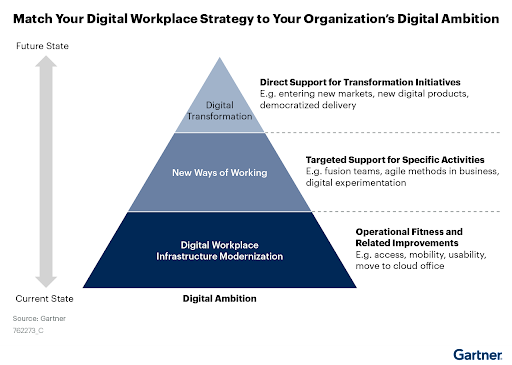Unpacking Gartner's Strategic Roadmap
What is the Digital Workplace of 2027?
The digital workplace is evolving amid demographic shifts, uncertainty over hybrid work as well as changing demands on IT. This roadmap describes the technology, talent and process changes that application leaders responsible for the digital workplace must address as they build their five year strategy.
KEY FINDINGS
- Gartner’s research found that 77% of digital workers have an IT specialist within their business unit. Business-led IT is becoming the norm as IT organisations reposition themselves to support improved business outcomes.
- Working style has shifted massively between 2020 and 2022. Both powered by remote and hybrid work and the surge of cloud office technology adoption. These then elevated the digital workplace to the forefront of the employee experience (EX). For some organisations, their digital workplace strategy exists solely to improve operational fitness. For those that aspire to true digital transformation however, their higher ambitions will necessitate a more complex and decentralised digital workplace.
RECOMMENDATIONS
Digital workplace leaders must:
- Plan for the governance and support of additional technology hubs by engaging with line-of-business leaders. To better understand their technology needs as well as building bridges with business technologists outside IT.
- Partner with HR to identify and implement a plan to upskill, attract or hire the additional resources required to implement and operate their future digital workplace strategy.
- Enable agile approaches by embracing business-led fusion teams, process automation and increased focus on stakeholder management and digital employee experience (DEX) improvements.
STRATEGIC PLANNING ASSUMPTION
Through 2027, multidisciplinary digital workplace teams that blend business and technology roles will be 50% more likely to deliver positive outcomes than those formed by IT alone.
The Scope of Your Organization’s Digital Workplace Applications Strategy Is Determined by Your Digital Ambition
The long-term goals of an organisation directly impact the scope of its digital workplace strategy and also the level of investment in it (see Figure 1).
These goals might include:
Infrastructure modernisation —
The digital workplace may be more tactical as it identifies, prioritises and oversees projects to incrementally improve operational fitness. This may be connected to a move from on-premises collaboration and productivity tools to new work hub suites. e.g. Microsoft 365, Google Workspace.
New ways of working —
The digital workplace may be targeted at specific areas of the business, collaboration methods or processes that benefit from both direct attention and evolution.
Digital transformation —
The digital workplace may be the vehicle to transform the business as a whole. It could also extend into new areas, products, channels or modes of delivery, scaling upward and outward.


Figure 1
